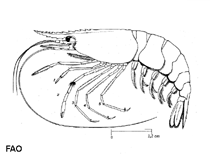Chlorotocus crassicornis (Costa, 1871)
Green shrimp| Native range | All suitable habitat | Point map | Year 2050 |

|
| This map was computer-generated and has not yet been reviewed. |
| Chlorotocus crassicornis AquaMaps Data sources: GBIF OBIS |
Classification / Names Common names | Synonyms | CoL | ITIS | WoRMS
Malacostraca | Decapoda | Pandalidae
Environment: milieu / climate zone / depth range / distribution range Ecology
Benthic; depth range 3 - 600 m (Ref. 804), usually 300 - 400 m (Ref. 804). Subtropical; 48°N - 37°S, 13°W - 139°E
Distribution Countries | FAO areas | Ecosystems | Occurrences | Introductions
Indo-West Pacific, Eastern Atlantic and the Mediterranean: eastern Atlantic from Gulf of Biscay to Congo and around the Mediterranean, and it is widely distributed throughout the coasts of Morocco.
Length at first maturity / Size / Weight / Age
Maturity: Lm ? range ? - ? cm Max length : 7.8 cm TL male/unsexed; (Ref. 804)
Minimum depth from Ref. 881.
Life cycle and mating behavior Maturity | Reproduction | Spawning | Eggs | Fecundity | Larvae
Members of the order Decapoda are mostly gonochoric. Mating behavior: Precopulatory courtship ritual is common (through olfactory and tactile cues); usually indirect sperm transfer.
Main reference
References | Coordinator | Collaborators
Bianchi, G., K.E. Carpenter, J.-P. Roux, F.J. Molloy, D. Boyer and H.J. Boyer. 1999. (Ref. 804)
IUCN Red List Status (Ref. 130435: Version 2024-1)
CITES status (Ref. 108899)
Not Evaluated
CMS (Ref. 116361)
Not Evaluated
Threat to humans
Human uses
| FishSource |
Tools
More information
Trophic Ecology
Ecology
Population dynamics
Life cycle
Distribution
Human Related
Aquaculture profile
Stamps, Coins Misc.
Stamps, Coins Misc.
Outreach
Taxonomy
References
Internet sources
BHL | BOLD Systems | CISTI | DiscoverLife | FAO(Publication : search) | Fishipedia | GenBank (genome, nucleotide) | GloBI | Gomexsi | Google Books | Google Scholar | Google | PubMed | Tree of Life | Wikipedia (Go, Search) | Zoological Record
Estimates based on models
Preferred temperature
(Ref. 115969): 8.6 - 15.9, mean 11.6 (based on 245 cells).
Resilience
(Ref. 69278):
High, minimum population doubling time less than 15 months (K=0.4-0.48).



